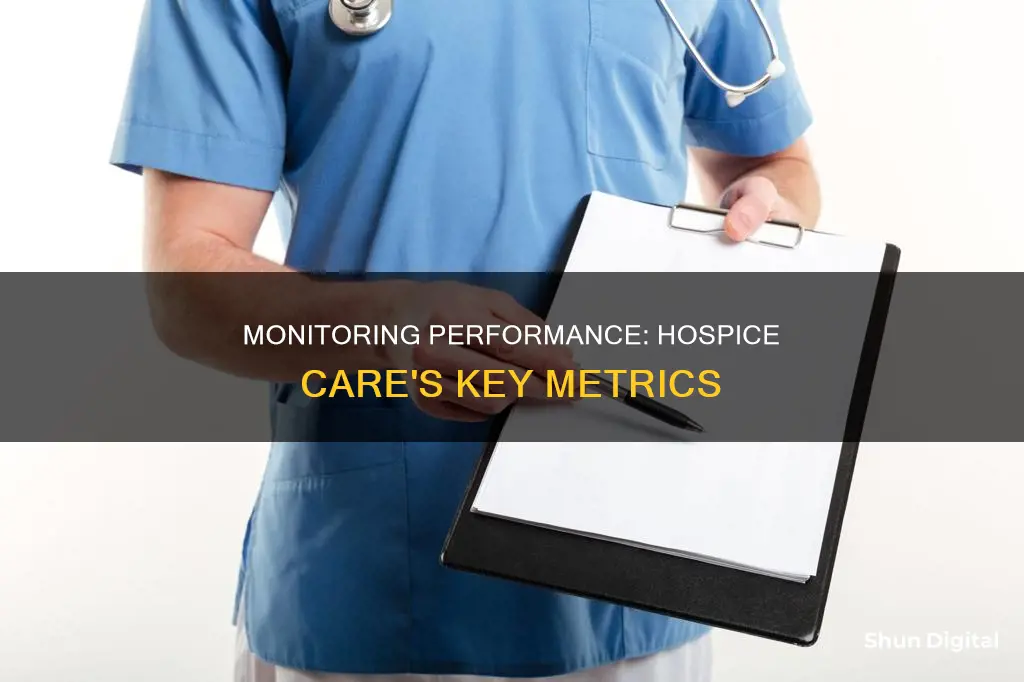
There are various ways in which hospice performance can be monitored. One way is through the use of data analytics and benchmarking, which allows hospices to compare their performance against national and state benchmarks and identify areas for improvement. Another way is through the use of quality measures (QMs), such as the Hospice Quality Reporting Program (HQRP), which uses the Hospice Item Set (HIS), Medicare claims data, and the Consumer Assessment of Healthcare Providers and Systems (CAHPS®) Hospice Survey to calculate performance on QMs. Additionally, tools such as the Palliative Performance Scale (PPS) can help assess a patient's functional decline and determine their eligibility for hospice care. By adopting these methods, hospices can ensure they are providing the best possible care to their patients and making informed decisions about their treatment and support.
| Characteristics | Values |
|---|---|
| Cost per patient day (PPD) | Varies depending on the level of care required by patients |
| Organization spend per patient | Compares the performance of one hospice with another, and takes into account fixed and variable costs |
| Inventory spend per patient | Measures the cost of medical and other supplies |
| Hospice visits in the last days of life (HVLDL) | Assesses hospice staff visits to patients at the end of life |
| Hospice Care Index (HCI) | Captures care processes occurring throughout the hospice stay, between admission and discharge |
| Palliative Performance Scale (PPS) | Assesses a patient's ability to function and helps determine how to move toward the end of life |
What You'll Learn
- Utilising the Palliative Performance Scale (PPS) to assess patient eligibility and functioning
- Monitoring patient vital signs, including blood pressure and heart rate
- Using data analytics and benchmarking to identify areas for improvement
- Tracking key performance indicators and comparing with national and state benchmarks
- Measuring costs per patient day and inventory spend per patient

Utilising the Palliative Performance Scale (PPS) to assess patient eligibility and functioning
The Palliative Performance Scale (PPS) is a validated and reliable tool used to assess a patient's day-to-day functioning and ability to perform activities. It is especially useful for patients nearing the end of their lives, helping physicians determine how best to support their patients. The PPS can be used to inform decisions about a patient's hospice eligibility by helping clinicians recognise a patient's functional decline. It is also used to assess patients' functional status and collaboratively establish palliative care plans.
The PPS uses five observer-rated domains correlated to the Karnofsky Performance Scale (100-0). It has been found to be useful for identifying and tracking the care needs of palliative care patients, particularly as these needs change with disease progression. The PPS can help determine when to have goals-of-care conversations with patients and their families.
For oncology patients, a PPS score of 70% or below may indicate hospice eligibility. For most other disease types, a patient with a PPS score of 50% or below may be hospice-eligible. A general way to determine this is to ask: "Does the patient with advanced illness spend more than 50% of their waking hours resting (sitting and lying)?"
While a physician's professional judgment remains key, the PPS can be a valuable tool for assessing patient eligibility and functioning in hospice care. It provides a structured framework to evaluate a patient's condition and needs, helping to ensure they receive the necessary support and care.
In addition to the PPS, there are other methods and measures used to monitor hospice performance. Benchmarking, for example, is a practice that involves comparing an organisation's performance to that of similar entities. This can help identify areas of improvement and efficient practices. Measures such as cost per patient day, organisation spend per patient, and inventory spend per patient are commonly used for benchmarking in hospice care.
Removing Taskbar from Secondary Monitor in Windows 8-10
You may want to see also

Monitoring patient vital signs, including blood pressure and heart rate
Monitoring patient vital signs is an essential part of hospice care. While the diagnosis and treatment are no longer the main focus, monitoring vital signs such as blood pressure and heart rate helps keep patients comfortable and relaxed.
Blood Pressure
Blood pressure is the force of the blood pushing against the artery walls during contraction and relaxation of the heart. When measuring blood pressure, two numbers are recorded: systolic and diastolic. The systolic pressure is the pressure inside the artery when the heart contracts and pumps blood through the body, while the diastolic pressure is the pressure inside the artery when the heart is at rest and filling with blood. Normal blood pressure is considered to be a systolic of less than 120 and diastolic of less than 80 (120/80). High blood pressure, or hypertension, increases the risk of heart attack, heart failure, and stroke.
Heart Rate
Heart rate, or pulse rate, is the number of times the heart beats per minute. The normal heart rate for healthy adults ranges from 60 to 100 beats per minute, although people who are more active may have slower heart rates. The pulse rate can be measured by feeling the beats in certain points of the body, such as the side of the neck, inside of the elbow, or wrist.
Monitoring Devices
Vital signs monitors are commonly used to measure blood pressure and heart rate. These devices can be portable and wireless, with sensors clipped to a patient's fingers or patched to the skin. The basic monitors show heart rate, blood pressure, and body temperature, while more advanced models also display oxygen saturation levels and respiration rate.
Manual Measurement
Blood pressure can also be measured manually using an aneroid monitor or a digital monitor. The aneroid monitor is less expensive and inflated by hand, but it can be easily damaged and may be inaccurate. The digital monitor is automatic and more popular due to its ease of use and easy-to-read recordings.
Factors Affecting Vital Signs
It is important to note that vital signs can be influenced by various factors. For example, body temperature can vary depending on gender, recent activity, food and fluid consumption, time of day, and menstrual cycle in women. Heart rate can be affected by exercise, illness, injury, and emotions.
Cleaning Monitors: Removing Dirt Marks and Smudges
You may want to see also

Using data analytics and benchmarking to identify areas for improvement
Benchmarking is a highly effective method for hospices to identify areas for improvement. It involves comparing an organisation's performance against similar operations to understand how well it is doing in comparison. This could mean comparing with other hospices in the area, similar organisations within the same group, or even on a departmental basis.
The fundamental principles of benchmarking are:
- Measurement of performance
- Identification of practices that yield the best results
- Adopting a process of continuous improvement
To be effective, the chosen parameters must be representative of what is being compared, and the same method of measurement must be used. Suggested parameters include:
- Cost per patient day (PPD)
- Organisation spend per patient
- Inventory spend per patient
Data analytics is another powerful tool for hospices to identify areas for improvement. SHP for Hospice, for example, is a real-time data and predictive analytics platform that enables hospices to effectively manage performance, stay compliant, and follow best practices. With access to a large database of national and state benchmarks, hospices can quickly identify areas for improvement and gain deeper insights to improve quality measures, case manager performance, and caregiver satisfaction.
The Palliative Performance Scale (PPS) is another tool that can be used to assess a patient's ability to function and determine how to move toward the end of life, including when to have goals-of-care conversations with patients and families. For patients with a PPS score of less than 70%, hospice care may be appropriate, as survival for more than 6 months is unlikely.
The Ultimate Guide to Updating Your ASUS 144Hz Monitor
You may want to see also

Tracking key performance indicators and comparing with national and state benchmarks
Tracking key performance indicators and comparing them with national and state benchmarks are crucial for evaluating and improving hospice care services. While there is no standard U.S. quality indicator set, several organizations have developed indicators and measurement tools to assess and enhance hospice performance.
The National Hospice and Palliative Care Organization (NHPCO), for instance, created the National Data Set (NDS) to understand demographics, practices, and outcomes; illustrate industry effectiveness; facilitate communication of industry legislative needs; and support agency performance improvement. The NDS provides invaluable data for comparative audits, clinical practice, and service management.
The Measuring What Matters (MWM) project, a joint initiative of the American Academy of Hospice and Palliative Medicine (AAHPM) and the Hospice and Palliative Nurses Association (HPNA), identified a set of top-ranked quality indicators for hospice and palliative care. These indicators cover various domains, including Structure and Process, Physical Aspects, Psychological and Psychiatric Aspects, Spiritual and Existential Aspects, and Ethical and Legal Aspects.
Additionally, benchmarking is a valuable practice for hospices to compare their performance with similar organizations. Concordance Healthcare Solutions suggests measures such as cost per patient day (PPD), organization spend per patient, and inventory spend per patient as key parameters for effective benchmarking. By selecting the right parameters and adopting a continuous improvement process, hospices can identify areas for enhancement and establish realistic performance indicators.
Furthermore, the Hospice Quality Reporting Program (HQRP) utilizes three data sources: the Hospice Item Set (HIS), Medicare claims data, and the Consumer Assessment of Healthcare Providers and Systems (CAHPS®) Hospice Survey, to calculate performance on Quality Measures (QMs). These data sources provide insights into areas such as comprehensive assessment at admission, hospice visits in the last days of life, and patient experience measures, enabling hospices to track their performance against national and state benchmarks.
Hooking Up Sega Genesis Classic to a Signage Monitor
You may want to see also

Measuring costs per patient day and inventory spend per patient
Benchmarking is a highly effective method for hospices to establish a baseline for their performance in comparison with their competition. Costs per patient day (PPD) are a useful measure for this, although other measures such as inventory cost and facility spend should also be evaluated for a more comprehensive understanding.
To calculate the cost per patient, it is important to evaluate all expenses, including fixed costs such as rent, water, electricity, and employee salaries, as well as variable costs like supplies, hygiene materials, and other operational expenses. This will give you a monthly amount needed to keep the hospice running, from which you can calculate the cost per patient according to the daily care capacity.
Additionally, direct expenses such as purchasing or leasing equipment and furniture, as well as depreciation and maintenance, should be included in the calculation. The cost of medical equipment, needles, paper towels, disposable safety items, and other inputs should be factored in when calculating the cost of medical procedures.
It is also crucial to consider the average time taken by doctors and employees to prepare procedures, rooms, and equipment. During this time, patients cannot be seen, and the cost of an empty room should be accounted for.
By setting the cost per hour of running the hospice and analysing the patients' profiles, purchasing power, and types of assistance, hospices can optimise their pricing models to generate the most revenue.
Inventory health is another critical aspect of hospice performance monitoring. It involves understanding customer buying behaviour and assessing inventory holdings relative to expected future customer demand. This helps hospices maintain optimal stock levels and reduce costs associated with overstocking or understocking.
Removing Monitor Tilt Stand: A Step-by-Step Guide for L197 Models
You may want to see also
Frequently asked questions
The Palliative Performance Scale (PPS) is a tool used to assess a patient's ability to function and determine how to move toward the end of life, including when to have goals-of-care conversations with patients and their families. Hospice care may be appropriate for patients with a PPS score of less than 70% as survival beyond six months is unlikely.
Hospices can use benchmarking to establish a baseline for how well they are performing in comparison to their competition. Measures such as costs per patient day (PPD), inventory cost, and facility spend are useful in this regard. Once a benchmark has been established, it is simple to monitor performance against it.
SHP for Hospice gives hospices access to real-time data and predictive analytics, allowing them to analyze performance and identify areas for improvement. With SHP, hospices can compare their performance to national and state benchmarks and monitor trends and track performance for any date range.







